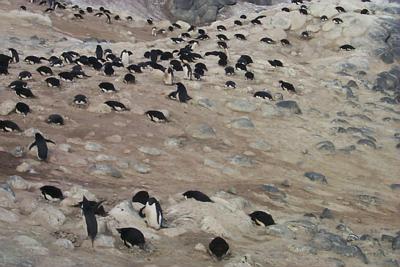6 January, 2000
It is snowing and actually a little cold out (about 20 deg. F) so I am
inside. Out the window, however I have the telescope trained on a group
of Adelie penguins sliding around on the sea ice. They seem to have
come to shore to spend the day, and are now moving back onto the ice.
To get around, the use a combination of walking and tobogganing. Walking
is a little tough for a penguin as their legs are about 3 inches long.
That is why they toboggan when they can. To do this they lay on their
bellies and push with their feet. If the ice is flat and smooth its a
great way to get a round. Its not so fun if they have to cross large
cracks and pressure ridges where the ice is lifted up. Dr. David
Ainley, the PI (principle investigator) of my project says they were
probably 2 year old birds that have no mate or nest.. These bachelors
tend to roam around with no parcticular direction in mind. By the third
or fourth year, Adelies start to look for a mate and begin nesting. This
begins in October. By December the eggs hatch, and the parents take
turns feeding the chicks. This keeps the parents busy. They may have to
travel 3 days or more to get food, which they transport in their
stomachs. Adelies eat fish and krill (a shrimp like crustacean). When
the adult returns to the nest, it regurgitates the food for the chicks.
As the chicks get a little older the parents stay away, except to feed
them. At this time the chicks stay with a large group of other chicks.
This is called a crèche, which is like a nursery. By the end of
January, the chicks begin to fledge or go to the sea. From there on,
they leave the parents, and are on their own. During the winter, the
birds stay with ice flows and move Northwards to escape the fast ice
(frozen solid with the permanent ice shelf).
Tomorrow, I will fly by helicopter to a place called Inclusion Hill,
which is above the Cape Bird rookery. There I will use radio telemetry
to track the positions of some birds that have tiny radio transmitters
taped to them. Some of the birds also have TDRs (time - depth
recorders) which tell us how deep the penguin is diving for food and for
how long they are under. This information tells us how penguins obtain
food and where they are going to get it. We also check to see what
exactly they are eating. This information will help us understand what
factors regulate the large penguin rookeries found in the area.
This may be my last journal entry for a while. There is no internet
access where I am traveling. Rather, I will be living in a Scott tent
high on a windy mountain. (Sounds nice!) I hope to be able to check in
whenever a helo flight permits during the next three weeks, but it is
possible that I will be in the field for the duration .
cheers,
Andre

This is an Adelie penguin rookery. The area is covered mainly by dirt with ice surrounding. There are, however a few rocks or pebbles, which are prized by the penguins. They are known to steal these pebbles form each others nest.
Contact the TEA in the field at
.
If you cannot connect through your browser, copy the
TEA's e-mail address in the "To:" line of
your favorite e-mail package.
|
